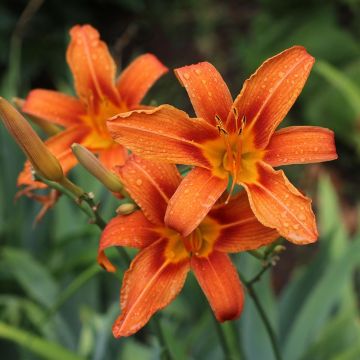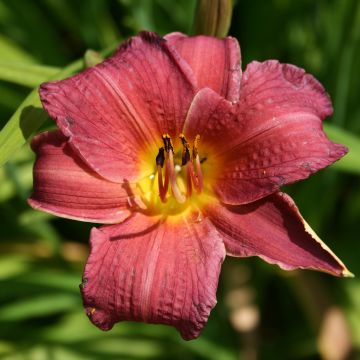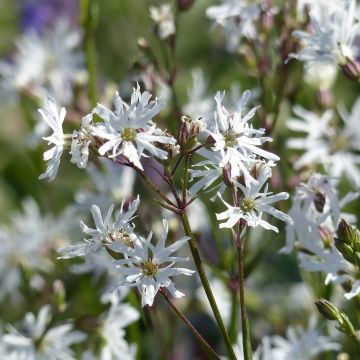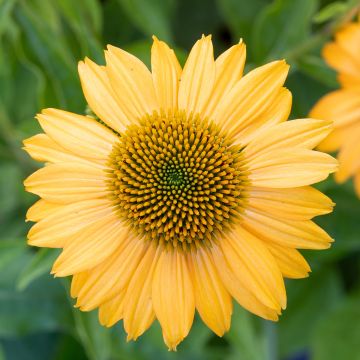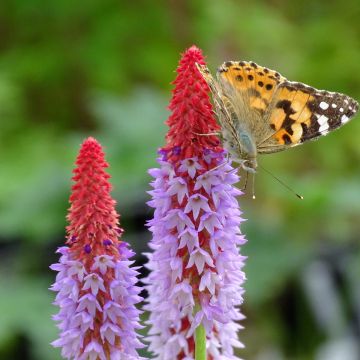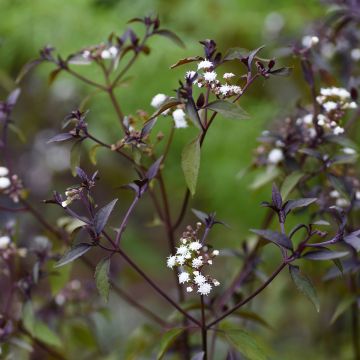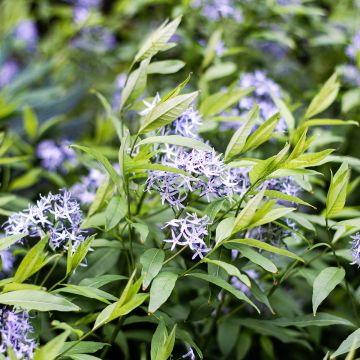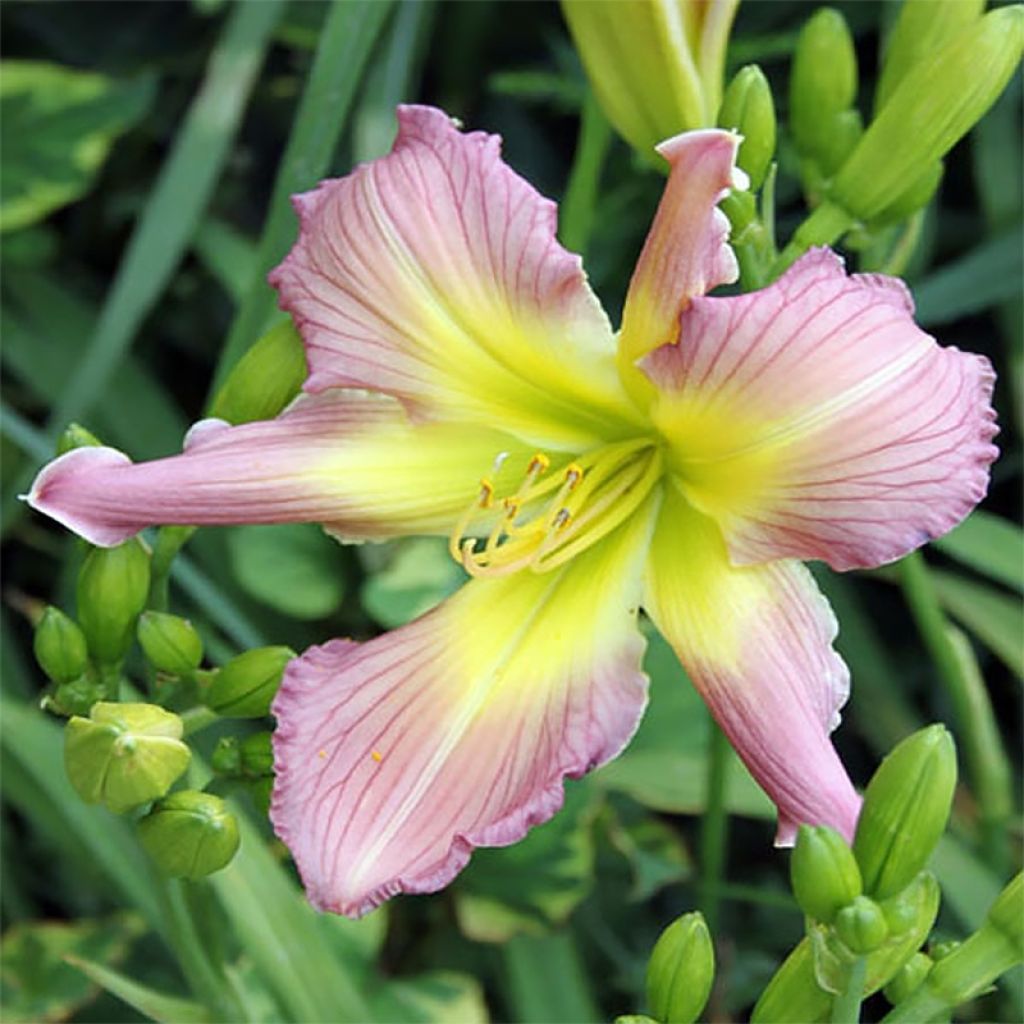

Hemerocallis Amerstone Amethyst Jewel - Daylily
Hemerocallis Amerstone Amethyst Jewel - Daylily
Hemerocallis Amerstone Amethyst Jewel
Daylily
This item cannot be shipped to the selected country
Delivery charge from €5.90
Delivery to Corse prohibited
More information
Schedule delivery date,
and select date in basket
This plant carries a 12 months recovery warranty
More information
We guarantee the quality of our plants for a full growing cycle, and will replace at our expense any plant that fails to recover under normal climatic and planting conditions.
From €5.90 for pickup delivery and €6.90 for home delivery
Express home delivery from €8.90.
Delivery to Corse prohibited: UE law prohibits the import of this plant from mainland France to Corse as part of the fight against Xylella fastidiosa. Please accept our sincere apologies.
More information
Does this plant fit my garden?
Set up your Plantfit profile →
Description
Hemerocallis 'Amerstone Amethyst Jewel' bears unusually shaped flowers with an unusual colour in summer which are delicately scented. They have slightly twisted petals with fringed edges, washed in lilac and amethyst, surrounding a wide yellow and green throat. This cultivar quickly forms beautiful clumps with deciduous foliage in winter. It is a mid-season variety that is subtly unique, perfect for combining with white or lemon yellow flowers in a border.
The genus Hemerocallis belongs to the family Liliaceae. They are perennial and hardy plants with deciduous foliage, which are sometimes semi-evergreen. The variety 'Amerstone Amethyst Jewel', obtained in 2001 by King-M, is the result of cross-breeding between the cultivars Fairy Summerbird and Dancing Summerbird. It forms a fairly dense clump that will reach about 64 cm (25in) in height, with a relative spread of 50 cm (20in). Daylilies tend to spread a little when they like the soil that they are planted in. The flowers measure about 10 cm (4in) in diameter, the petals in this variety are somewhat irregular in shape, more or less concave and undulating at the edges. Each flower blooms in the morning and lasts only a day, but the flowering continuously renews over a beautiful period in June-July. Each flower stem has 3 branches, about 25 flower buds in total. The foliage is linear, bright green and deciduous in winter : it emerges from the ground in spring and dries up in autumn. Daylilies are plants with short rhizomes and fleshy roots that tolerate dry soils, but are more opulent and floriferous in moist soil.
Very easy to grow, these plants thrive in both shade and sun. Some of them can be a little invasive, so do not hesitate to divide the clumps every four or five years, preferably in autumn, after flowering. Daylilies are often called 'the perfect perennial plant', because of their vibrant colours, their ability to tolerate any type of environment, but also due to their lack of modesty, they have a beautiful exuberance that goes well with other perennials. Plant them in generous clumps at the back of your borders. All summer bulbs (lilies, agapanthus, Ixias...) can be planted alongside daylilies. 'Amerstone Amethyst Jewel' is a refined variety, to be highlighted alongside white or yellow blooms: for example daylilies 'Alice in Wonderland' or 'Gentle Shepherd'. Add some perennial flaxes, erigerons and chamomiles for example. The flowers are edible: they brighten up salads and decorate desserts.
Report an error about the product description
Hemerocallis Amerstone Amethyst Jewel - Daylily in pictures


Flowering
Foliage
Plant habit
Botanical data
Hemerocallis
Amerstone Amethyst Jewel
Hemerocallidaceae (Liliaceae)
Daylily
Cultivar or hybrid
Other Hemerocallis - Daylilies
Planting and care
Plant your Hemerocallis 'Amerstone Amethyst Jewel' in good garden soil that is not too heavy with clay and that is enriched with humus and compost. In these conditions, your perennial will have good tolerance towards summer droughts and will not suffer from winter frosts. Very easy to grow, this variety is not susceptible to parasites or diseases, so there is no need to treat it and rodents are not interested in it. Daylilies thrive both in partial shade and in full sun, with 4 to 5 hours of daily sunlight being sufficient. Plant by burying the collar 3 to 4 cm (1 to 2in) below the surface. If you plant several of them, do not space them too close together as the gaps will be quickly filled. For a few weeks after planting, it is good to keep the soil moist. Divide the clumps preferably in autumn after flowering.
Planting period
Intended location
Care
-
, onOrder confirmed
Reply from on Promesse de fleurs
Summer flowering perennials
Haven't found what you were looking for?
Hardiness is the lowest winter temperature a plant can endure without suffering serious damage or even dying. However, hardiness is affected by location (a sheltered area, such as a patio), protection (winter cover) and soil type (hardiness is improved by well-drained soil).

Photo Sharing Terms & Conditions
In order to encourage gardeners to interact and share their experiences, Promesse de fleurs offers various media enabling content to be uploaded onto its Site - in particular via the ‘Photo sharing’ module.
The User agrees to refrain from:
- Posting any content that is illegal, prejudicial, insulting, racist, inciteful to hatred, revisionist, contrary to public decency, that infringes on privacy or on the privacy rights of third parties, in particular the publicity rights of persons and goods, intellectual property rights, or the right to privacy.
- Submitting content on behalf of a third party;
- Impersonate the identity of a third party and/or publish any personal information about a third party;
In general, the User undertakes to refrain from any unethical behaviour.
All Content (in particular text, comments, files, images, photos, videos, creative works, etc.), which may be subject to property or intellectual property rights, image or other private rights, shall remain the property of the User, subject to the limited rights granted by the terms of the licence granted by Promesse de fleurs as stated below. Users are at liberty to publish or not to publish such Content on the Site, notably via the ‘Photo Sharing’ facility, and accept that this Content shall be made public and freely accessible, notably on the Internet.
Users further acknowledge, undertake to have ,and guarantee that they hold all necessary rights and permissions to publish such material on the Site, in particular with regard to the legislation in force pertaining to any privacy, property, intellectual property, image, or contractual rights, or rights of any other nature. By publishing such Content on the Site, Users acknowledge accepting full liability as publishers of the Content within the meaning of the law, and grant Promesse de fleurs, free of charge, an inclusive, worldwide licence for the said Content for the entire duration of its publication, including all reproduction, representation, up/downloading, displaying, performing, transmission, and storage rights.
Users also grant permission for their name to be linked to the Content and accept that this link may not always be made available.
By engaging in posting material, Users consent to their Content becoming automatically accessible on the Internet, in particular on other sites and/or blogs and/or web pages of the Promesse de fleurs site, including in particular social pages and the Promesse de fleurs catalogue.
Users may secure the removal of entrusted content free of charge by issuing a simple request via our contact form.
The flowering period indicated on our website applies to countries and regions located in USDA zone 8 (France, the United Kingdom, Ireland, the Netherlands, etc.)
It will vary according to where you live:
- In zones 9 to 10 (Italy, Spain, Greece, etc.), flowering will occur about 2 to 4 weeks earlier.
- In zones 6 to 7 (Germany, Poland, Slovenia, and lower mountainous regions), flowering will be delayed by 2 to 3 weeks.
- In zone 5 (Central Europe, Scandinavia), blooming will be delayed by 3 to 5 weeks.
In temperate climates, pruning of spring-flowering shrubs (forsythia, spireas, etc.) should be done just after flowering.
Pruning of summer-flowering shrubs (Indian Lilac, Perovskia, etc.) can be done in winter or spring.
In cold regions as well as with frost-sensitive plants, avoid pruning too early when severe frosts may still occur.
The planting period indicated on our website applies to countries and regions located in USDA zone 8 (France, United Kingdom, Ireland, Netherlands).
It will vary according to where you live:
- In Mediterranean zones (Marseille, Madrid, Milan, etc.), autumn and winter are the best planting periods.
- In continental zones (Strasbourg, Munich, Vienna, etc.), delay planting by 2 to 3 weeks in spring and bring it forward by 2 to 4 weeks in autumn.
- In mountainous regions (the Alps, Pyrenees, Carpathians, etc.), it is best to plant in late spring (May-June) or late summer (August-September).
The harvesting period indicated on our website applies to countries and regions in USDA zone 8 (France, England, Ireland, the Netherlands).
In colder areas (Scandinavia, Poland, Austria...) fruit and vegetable harvests are likely to be delayed by 3-4 weeks.
In warmer areas (Italy, Spain, Greece, etc.), harvesting will probably take place earlier, depending on weather conditions.
The sowing periods indicated on our website apply to countries and regions within USDA Zone 8 (France, UK, Ireland, Netherlands).
In colder areas (Scandinavia, Poland, Austria...), delay any outdoor sowing by 3-4 weeks, or sow under glass.
In warmer climes (Italy, Spain, Greece, etc.), bring outdoor sowing forward by a few weeks.

































